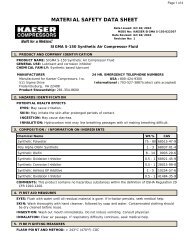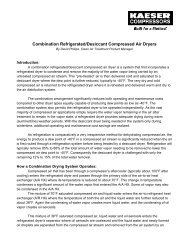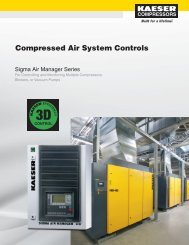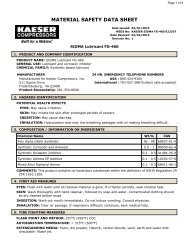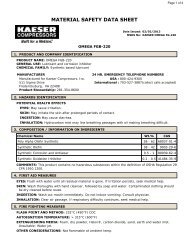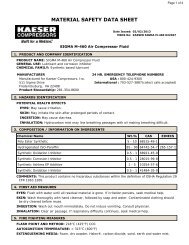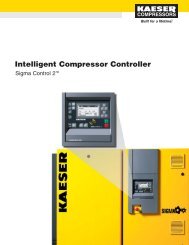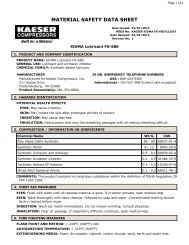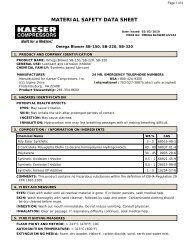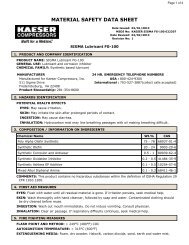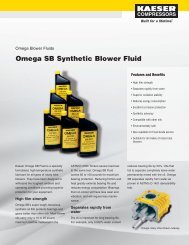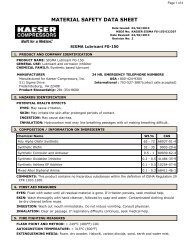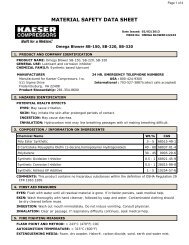Basics of rotary screw compressor lubricants - Kaeser Compressors
Basics of rotary screw compressor lubricants - Kaeser Compressors
Basics of rotary screw compressor lubricants - Kaeser Compressors
You also want an ePaper? Increase the reach of your titles
YUMPU automatically turns print PDFs into web optimized ePapers that Google loves.
White Paper: <strong>Basics</strong> <strong>of</strong> Rotary Screw Compressor Lubricants<br />
Storage, handling and transferring <strong>lubricants</strong> affect<br />
the cleanliness <strong>of</strong> the fluid. It is very important<br />
to use only clean, dedicated containers and<br />
transfer pumps. Do not use one pump for several<br />
different fluids. Even a small amount <strong>of</strong> residual<br />
fluid in a pump can contaminate an entire sump.<br />
Conclusion<br />
Lubricant is a critical component in <strong>rotary</strong> <strong>screw</strong><br />
<strong>compressor</strong>s. Its condition is the key element in<br />
determining the service life <strong>of</strong> the machine, and it<br />
is constantly exposed to contamination. In order<br />
to maximize the service life <strong>of</strong> the <strong>compressor</strong>,<br />
follow these rules:<br />
1. Locate the <strong>compressor</strong> inlet to draw clean,<br />
cool air.<br />
2. If the <strong>compressor</strong> is air-cooled, provide<br />
clean, cool air to inlet <strong>of</strong> the cooling air system.<br />
Keep coolers clean.<br />
3. If the <strong>compressor</strong> is water-cooled, provide<br />
clean, cool water to the heat exchanger. Clean or<br />
replace the cooler if it becomes fouled. Fouling<br />
restricts heat transfer.<br />
4. Sample the lubricant frequently.<br />
5. Stop the <strong>compressor</strong> once per week and<br />
check for water in the separator reservoir. Drain<br />
<strong>of</strong>f any water found. In hot and humid environments,<br />
this may have to be done more <strong>of</strong>ten.<br />
6. Inlet filtration is the first line <strong>of</strong> defense.<br />
Clean the inlet filter <strong>of</strong>ten and replace when<br />
required. Examine the connection between the<br />
filter and the airend for leaks to make certain no<br />
ambient air is drawn in behind the filter. Check<br />
filter fit for a good seal.<br />
7. Change the lubricant before it gets near<br />
the end <strong>of</strong> its life. Depleted lubricant left in a<br />
<strong>compressor</strong> (even a relatively small amount) can<br />
significantly reduce the service life <strong>of</strong> the new<br />
lubricant. If the lubricant has started to fail, use a<br />
lubricant flush prior to changing the fluid.<br />
8. Properly apply <strong>compressor</strong>s to avoid low<br />
duty cycles, keeping temperatures within their<br />
designed operating range.<br />
Contact us to learn more:<br />
<strong>Kaeser</strong> <strong>Compressors</strong>, Inc.<br />
877-586-2691<br />
www.kaeser.com<br />
info.usa@kaeser.com<br />
<strong>Kaeser</strong> <strong>Compressors</strong>, Inc. 877-586-2691 www.kaeser.com



